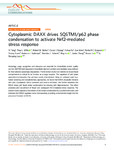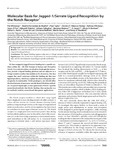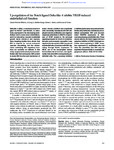The Possible Role of TGF-β-Induced Suppressors of Cytokine Signaling Expression in Osteoclast/Macrophage Lineage Commitment In Vitro.
| dc.contributor.author | Fox, Simon | |
| dc.contributor.author | Haque, LJ | |
| dc.contributor.author | Lovibond, AJ | |
| dc.contributor.author | Chambers, TJ | |
| dc.date.accessioned | 2023-02-15T15:39:04Z | |
| dc.date.available | 2023-02-15T15:39:04Z | |
| dc.date.issued | 2003-04-01 | |
| dc.identifier.issn | 0022-1767 | |
| dc.identifier.issn | 1550-6606 | |
| dc.identifier.uri | http://hdl.handle.net/10026.1/20394 | |
| dc.description.abstract |
<jats:title>Abstract</jats:title> <jats:p>Osteoclast formation is dependent on the ability of TGF-β to enable receptor activator of NF-κB ligand (RANKL)-induced commitment of hemopoietic precursors to the osteoclastic lineage. The mechanism by which TGF-β enables formation is unknown. One possibility is that TGF-β opposes Janus kinase (JAK)/STAT signals generated by inhibitory cytokines such as IFN-β. The JAK/STAT pathway is activated by cytokines that induce resistance to osteoclast formation, such as IFN-γ and M-CSF, and the effect of these is opposed by TGF-β. Recently, a group of STAT-induced factors, termed suppressors of cytokine signaling (SOCS), has been identified that inhibit JAK/STAT signals. Therefore, we tested the ability of TGF-β to induce SOCS expression in osteoclast precursors and examined the effect of SOCS expression on osteoclast/macrophage lineage commitment. We found that while SOCS mRNA is undetectable in macrophages, osteoclasts express SOCS-3, and TGF-β up-regulates this expression. Furthermore, TGF-β rapidly induces sustained SOCS-3 expression in macrophage/osteoclast precursors. To determine whether SOCS-3 plays a role in osteoclast differentiation we expressed SOCS-3 in precursors using a retroviral system. We found that osteoclast differentiation was significantly enhanced in SOCS-3-infected precursors, and SOCS-3 expression enables formation in the presence of anti-TGF-β Ab. On the other hand, antisense knockdown of SOCS-3 strongly suppressed osteoclast formation and significantly blunted the response to TGF-β. Moreover, like TGF-β, SOCS-3 expression opposed the inhibitory effect of IFN-β. These data suggest that TGF-β-induced expression of SOCS-3 may represent a mechanism by which TGF-β suppresses inhibitory cytokine signaling, priming precursors for a role in bone resorption.</jats:p> | |
| dc.format.extent | 3679-3687 | |
| dc.format.medium | ||
| dc.language | en | |
| dc.language.iso | en | |
| dc.publisher | The American Association of Immunologists | |
| dc.subject | Animals | |
| dc.subject | Bone Marrow Cells | |
| dc.subject | Carrier Proteins | |
| dc.subject | Cell Differentiation | |
| dc.subject | Cell Lineage | |
| dc.subject | Cytokines | |
| dc.subject | Genetic Vectors | |
| dc.subject | Glycoproteins | |
| dc.subject | Interferon-beta | |
| dc.subject | Macrophages | |
| dc.subject | Male | |
| dc.subject | Membrane Glycoproteins | |
| dc.subject | Mice | |
| dc.subject | Oligodeoxyribonucleotides, Antisense | |
| dc.subject | Osteoclasts | |
| dc.subject | Osteoprotegerin | |
| dc.subject | Protein Biosynthesis | |
| dc.subject | Protein-Tyrosine Kinases | |
| dc.subject | Proteins | |
| dc.subject | RANK Ligand | |
| dc.subject | RNA, Messenger | |
| dc.subject | Receptor Activator of Nuclear Factor-kappa B | |
| dc.subject | Receptors, Cytoplasmic and Nuclear | |
| dc.subject | Receptors, Tumor Necrosis Factor | |
| dc.subject | Repressor Proteins | |
| dc.subject | Retroviridae | |
| dc.subject | Signal Transduction | |
| dc.subject | Stem Cells | |
| dc.subject | Suppressor of Cytokine Signaling 3 Protein | |
| dc.subject | Suppressor of Cytokine Signaling Proteins | |
| dc.subject | Transcription Factors | |
| dc.subject | Transforming Growth Factor beta | |
| dc.title | The Possible Role of TGF-β-Induced Suppressors of Cytokine Signaling Expression in Osteoclast/Macrophage Lineage Commitment In Vitro. | |
| dc.type | journal-article | |
| dc.type | Article | |
| plymouth.author-url | https://www.webofscience.com/api/gateway?GWVersion=2&SrcApp=PARTNER_APP&SrcAuth=LinksAMR&KeyUT=WOS:000181754100030&DestLinkType=FullRecord&DestApp=ALL_WOS&UsrCustomerID=11bb513d99f797142bcfeffcc58ea008 | |
| plymouth.issue | 7 | |
| plymouth.volume | 170 (7) | |
| plymouth.publication-status | Published | |
| plymouth.journal | The Journal of Immunology | |
| dc.identifier.doi | 10.4049/jimmunol.170.7.3679 | |
| plymouth.organisational-group | /Plymouth | |
| plymouth.organisational-group | /Plymouth/Faculty of Health | |
| plymouth.organisational-group | /Plymouth/Faculty of Health/School of Biomedical Sciences | |
| plymouth.organisational-group | /Plymouth/Research Groups | |
| plymouth.organisational-group | /Plymouth/Research Groups/Institute of Translational and Stratified Medicine (ITSMED) | |
| plymouth.organisational-group | /Plymouth/Research Groups/Institute of Translational and Stratified Medicine (ITSMED)/CBR | |
| plymouth.organisational-group | /Plymouth/Research Groups/Plymouth Institute of Health and Care Research (PIHR) | |
| plymouth.organisational-group | /Plymouth/Users by role | |
| plymouth.organisational-group | /Plymouth/Users by role/Academics | |
| dc.publisher.place | United States | |
| dc.identifier.eissn | 1550-6606 | |
| dc.rights.embargoperiod | Not known | |
| rioxxterms.versionofrecord | 10.4049/jimmunol.170.7.3679 | |
| rioxxterms.licenseref.uri | http://www.rioxx.net/licenses/all-rights-reserved | |
| rioxxterms.type | Journal Article/Review |





